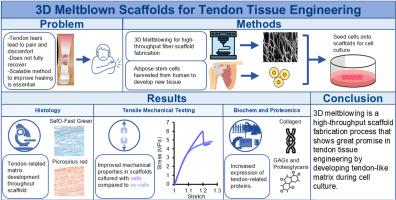Three-dimensional meltblowing as a high-speed fabrication process for tendon tissue engineered scaffolds
Q1 Computer Science
引用次数: 0
Abstract
Rotator cuff tears continue to be a critical challenge for successful repair due to the formation of fibrotic scar tissue during healing. Tendon tissue engineering seeks to improve these outcomes using nonwoven fabrication methods to produce biomimetic scaffolds. Meltblowing has several advantages over other nonwoven approaches including non-toxic fabrication processes and being high-throughput and economical, while accurately producing fiber diameters comparable to native tendon microstructure. Recently 3D meltblowing (3DMB) introduced high degrees of tunability to the core process, allowing for production of highly aligned fiber mats at anatomically relevant dimensions. Here, we evaluated 3DMB scaffolds fabricated using poly-L-lactic acid (PLA) and poly-ε-caprolactone (PCL) by characterizing scaffold properties before and after culture with human adipose stem cells (hASCs). Mechanical and fiber characterization of 3DMB scaffolds closely resembled tendon microarchitecture by exhibiting high fiber alignment and mechanical anisotropy. hASC-seeded 3DMB scaffolds after 28 days of culture proliferated and deposited aligned tendon-like extracellular matrix. Furthermore, cell culture enhanced the Young's modulus of PLA 3DMB scaffolds and improved yield stress, yield stretch, and stiffness of both 3DMB scaffolds. The proteome of cultured 3DMB scaffolds increased expression of tendon-related proteins after 28 days of culture, but polymer-dependent differences in glycoprotein composition was observed. Together, 3DMB is a promising method for tendon tissue engineering, by showing improved fiber and mechanical properties compared to meltblown scaffolds. However, while an improvement on prior iterations, continued development of this 3DMB technology is needed to better mimic the mechanical properties and biologic composition of native tendon.

三维熔喷法制备肌腱组织工程支架
由于纤维化瘢痕组织在愈合过程中的形成,肩袖撕裂仍是成功修复的关键挑战。肌腱组织工程学试图利用无纺布制造方法来生产仿生物支架,从而改善这些结果。与其他无纺布方法相比,熔喷技术具有多项优势,包括无毒制造工艺、高通量和经济性,同时还能精确制造出与原生肌腱微观结构相当的纤维直径。最近,三维熔喷(3DMB)为核心工艺引入了高度可调性,可生产出解剖相关尺寸的高度对齐的纤维毡。在此,我们评估了使用聚左旋乳酸(PLA)和聚ε-己内酯(PCL)制作的三维MB支架,在培养人脂肪干细胞(hASCs)前后对支架特性进行了表征。三维MB支架的机械和纤维特性与肌腱的微结构非常相似,表现出高度的纤维排列和机械各向异性。此外,细胞培养还提高了聚乳酸三维MB支架的杨氏模量,改善了两种三维MB支架的屈服应力、屈服拉伸和刚度。培养三维MB支架的蛋白质组在培养28天后增加了肌腱相关蛋白的表达,但观察到糖蛋白组成的差异取决于聚合物。总之,与熔喷支架相比,三维MB具有更好的纤维和机械性能,是一种很有前景的肌腱组织工程方法。不过,虽然三维MB技术比以前的迭代技术有所改进,但仍需继续开发,以更好地模拟原生肌腱的机械性能和生物组成。
本文章由计算机程序翻译,如有差异,请以英文原文为准。
求助全文
约1分钟内获得全文
求助全文
来源期刊

Bioprinting
Computer Science-Computer Science Applications
CiteScore
11.50
自引率
0.00%
发文量
72
审稿时长
68 days
期刊介绍:
Bioprinting is a broad-spectrum, multidisciplinary journal that covers all aspects of 3D fabrication technology involving biological tissues, organs and cells for medical and biotechnology applications. Topics covered include nanomaterials, biomaterials, scaffolds, 3D printing technology, imaging and CAD/CAM software and hardware, post-printing bioreactor maturation, cell and biological factor patterning, biofabrication, tissue engineering and other applications of 3D bioprinting technology. Bioprinting publishes research reports describing novel results with high clinical significance in all areas of 3D bioprinting research. Bioprinting issues contain a wide variety of review and analysis articles covering topics relevant to 3D bioprinting ranging from basic biological, material and technical advances to pre-clinical and clinical applications of 3D bioprinting.
 求助内容:
求助内容: 应助结果提醒方式:
应助结果提醒方式:


